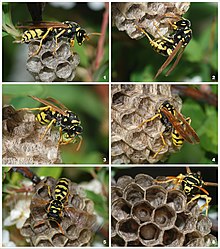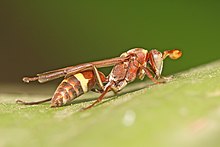| Revision as of 01:05, 24 June 2024 editMbdfar (talk | contribs)Extended confirmed users14,396 edits →Brood rearing: Sentence case header per MOSTags: Mobile edit Mobile web edit Advanced mobile edit← Previous edit | Revision as of 02:45, 3 July 2024 edit undoJoshenders (talk | contribs)36 editsm Improves readability of opening paragraphNext edit → | ||
| Line 14: | Line 14: | ||
| ] nest (]); concealed comb]] | ] nest (]); concealed comb]] | ||
| '''Paper wasps''' are ] ]s |
'''Paper wasps''' are a type of ] ]s. The term is typically used to refer to members of the vespid subfamily ], though it often colloquially includes members of the subfamilies ] (]s and ]s) and ], which also make nests out of paper. | ||
| Paper wasp nests are characterized by open combs with down pointing cells. Some types of paper wasps are occasionally referred to as, '''umbrella wasps''', due to the distinctive design of their nests.<ref name=enc> Microsoft Encarta Online Encyclopedia 2006.</ref> | |||
| == Species == | == Species == | ||
Revision as of 02:45, 3 July 2024
Vespid wasps that gather fibers from dead wood and plant stems
| Paper wasp | |
|---|---|

| |
| A young paper wasp queen (Polistes gallicus) starting a new colony | |
| Scientific classification | |
| Domain: | Eukaryota |
| Kingdom: | Animalia |
| Phylum: | Arthropoda |
| Class: | Insecta |
| Order: | Hymenoptera |
| Superfamily: | Vespoidea |
| Family: | Vespidae |
| Subfamilies with paper wasp species | |


Paper wasps are a type of vespid wasps. The term is typically used to refer to members of the vespid subfamily Polistinae, though it often colloquially includes members of the subfamilies Vespinae (hornets and yellowjackets) and Stenogastrinae, which also make nests out of paper.
Paper wasp nests are characterized by open combs with down pointing cells. Some types of paper wasps are occasionally referred to as, umbrella wasps, due to the distinctive design of their nests.
Species
Approximately 300 species of Polistes paper wasps have been identified worldwide. The most common paper wasp in Europe is Polistes dominula. The Old World tribe Ropalidiini contains another 300 species, and the Neotropical tribes Epiponini and Mischocyttarini each contain over 250 more, so the total number of true paper wasps worldwide is about 1100 species, almost half of which can be found in the neotropics.
Nests

The nests of most true paper wasps are characterized by having open combs with cells for brood rearing. The wasps gather fibers from dead wood and plant stems, which they mix with saliva, and use to construct nests that appear made out of gray or brown papery material. A 'petiole', or constricted stalk attaches the nest to a branch or other structure. The wasps secrete an ant repellent chemical which they spread around the base of the petiole or anchor to prevent the loss of eggs or brood.
Most social wasps of the family Vespidae make nests from paper, but some stenogastrine species, such as Liostenogaster flavolineata, use mud. A small group of eusocial crabronid wasps, of the genus Microstigmus (the only eusocial wasps outside the family Vespidae), also constructs nests out of chewed plant fibers, though the nest consistency is quite different from those of true paper wasps, due to the absence of wood fibers, and the use of silk extruded by female wasps to bind the fibers.
Nests can be found in sheltered areas, such as the eaves of a house, the branches of a tree, on the end of an open pipe, or on an old clothesline. Some species, such as Ropalidia romandi, will vary their nest architecture depending on where they build their nest.
Three species of Polistes are obligate social parasites, and have lost the ability to build their own nests, and are sometimes referred to as "cuckoo paper wasps". They rely on the nests of their hosts to raise their brood. A few hornets and yellowjackets are also brood parasites (e.g., Vespula austriaca).
Brood rearing
In temperate climates, in the fall, reproductive males and females are reared. They fly away and mate. Only the new queens hibernate overwinter in a sheltered location. In the spring each searches for a suitable location and starts and maintains a new nest typically by herself until the first brood of female workers matures and helps in all activities except egg laying.
Once eggs hatch, the legless larvae remain in their cells to be taken care of. The wasps hunt prey, primarily caterpillars, but also other insects like flies, and beetle larvae. The adult cuts up the prey and masticates it (thoroughly chewing it) prior to feeding it to the larvae.
Water is also provided for the larva. Wasps may find a puddle or stream or dew that has collected at the base of some leaves.
When the larvae mature, they pupate in their cell and the workers cap the cell, sealing them in until the adult breaks out of its pupal shell. The open nest is light colored reflecting light and the nest material provides some insulation, even so it can be subjected to elevated temperatures with sun exposure or high ambient temperatures. The wasps can cool their nest by fanning their wings and/or bringing water to place in the nest letting evaporation provide substantial cooling.
Behavior
Unlike yellowjackets and hornets, which can be very aggressive, polistine paper wasps will generally only attack if they themselves or their nest are threatened. Their territoriality can lead to attacks on people, and their stings are quite painful and – like all venomous animals – can produce a potentially fatal anaphylactic reaction in some individuals. A study conducted on European paper wasps (Polistes dominula) concluded that wasps with brighter aposematic colors are more venomous, because they have larger venom glands, and offer a stronger warning signal to organisms threatening the nest.


Most wasps are beneficial in their natural habitat and are critically important in natural biocontrol. Paper wasps feed on sugars like nectar, aphid honeydew and the sugary liquid produced by their larvae. Because they are a known pollinator and feed on known garden pests, paper wasps are often considered to be beneficial by gardeners.
When threatened, the wasps have a variety of responses depending upon the severity. The first level is posturing. They face the perceived threat, stand tall and raise their wings.
At a higher level they run round the nest surface and finally with sufficient disturbance, fly around the nest attempting to locate the source, chasing and stinging the threat. They use alarm pheromones to coordinate their response.
See also
References
- "Paper Wasp" Microsoft Encarta Online Encyclopedia 2006.
- James M. Carpenter. "Distributional checklist of the species of the genus Polistes (Hymenoptera: Vespidae; Polistinae, Polistini)". Archived from the original on 2009-07-10. Retrieved 2009-02-09.
- ^ Lyon, W.F. and G.S. Wegner (1991). Paper Wasps and Hornets Archived 2001-04-25 at the Wayback Machine Ohio State University Extension Fact Sheet: Entomology
- Post, David C; Jeanne, Robert L (July 1981). "Colony Defense against Ants by Polistes fuscatus (Hymenoptera: Vespidae) in Wisconsin". Journal of the Kansas Entomological Society. 54 (3): 599. JSTOR 25084198. Retrieved 18 December 2021.
- Matthews, R. W.; Starr, C. K. (1984). "Microstigmus comes Wasps have a Method of Nest Construction Unique Among Social Insects". Biotropica. 16 (1): 55–58. doi:10.2307/2387895. JSTOR 2387895.
- Yamane, Soichi; Ito, Yosiaki (1994). "Nest Architecture of the Australian Paper Wasp Ropalidia Romandi Cabeti , With a Note on its Developmental Process (Hymenoptera: Vespidae)". Psyche: A Journal of Entomology. 101 (3–4): 145–158. doi:10.1155/1994/92839.
- Dapporto L, Cervo R, Sledge MF, Turillazzi S (2004) "Rank integration in dominance hierarchies of host colonies by the paper wasp social parasite Polistes sulcifer (Hymenoptera, Vespidae)". J Insect Physiol 50 :217–223
- Archer, M.E. (1998). "Vespula austriaca (Panzer, 1799)". Bees, Wasps & Ants Recording Society. BWARS. Retrieved 15 Oct 2014.
- Felixson, Carol (undated). "Paper wasps work together." Retrieved 2009-04-26 from "L.A. Times" at .
- ^ Drees, B.M. and John Jackman (1999). Field Guide to Texas Insects. Gulf Publishing Company, Houston, Texas. Excerpt available at: Texas Cooperative extension Archived 2006-12-05 at the Wayback Machine
- Vidal-Cordero, J; Moreno-Rueda, Gregorio; López-Orta, Antonio; Marfil-Daza, Carlos; Ros-Santaella, José L; Ortiz-Sánchez, F (2012). "Brighter-colored paper wasps (Polistes dominula) have larger poison glands". Frontiers in Zoology. 9 (1): 20. doi:10.1186/1742-9994-9-20. ISSN 1742-9994. PMC 3495029. PMID 22901602.
External links
- National Geographic News: Wasps Can Recognize Faces. Retrieved 2012-12-04.